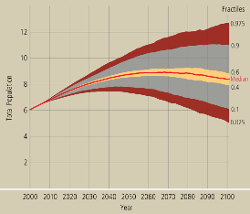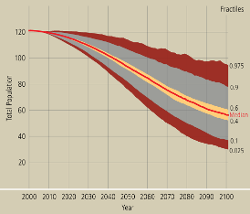Population Projections
In mid-2007 the World Population Program (POP) produced its second set of world population projections. This used the same long-term assumptions about the future levels of fertility, mortality, and migration as the first study in 2001, but incorporated all the new empirical evidence that had become available in the interim.
FAST FACTS
Africa’s population is set to more than double from its current level of around 740 million. Radical policy changes are needed to keep Africa off the bottom of the world development league, such as better education and environmental and agricultural improvements.
Against expectations, there has been continued low fertility (together with significant out-migration in most of the countries) since 1990 in Eastern Europe, with fewer and fewer women are entering reproductive age. The population size is likely to decline to less than half its current level by the end of the century.
After an initial increase, China’s population is likely to be back down to its 2000 level during the 2040s and then, by the end of the century, possibly almost down to half the 2000 level.
About the 2007 projections
The new results show significant changes in the outlook for certain regions. As these go in opposite directions and partly offset each other, however, the aggregate results at the global level remain very stable in comparison with the 2001 projections. The 2007 projections also show that world population will peak during this century in around 2070 at around 9 billion, virtually unchanged from 2001. By mid-century the 80% uncertainty range for world population is 7.8 to 9.9 billion. By 2100 it further broadens to 6.2–11.1 billion. In other words, there is a more than a 10% chance that the world population in 2100 will be smaller than it is today and an equal chance it could be more than 11 billion. However, a further doubling of world population from currently 6.6 to 13.2 billion is seen as a less than 2% chance from today’s perspective.
How the 2007 projections work
The detailed results for ten indicators for individual years from 2008 to 2100 for 13 world regions as well as for the world as a whole is given in ten Excel files: Total Population, Mean Age, Proportion Below Age 20, Proportion 20–60, Proportion Above Age 60, Proportion Above Age 80, Old Age Dependency Ratio (60+/20–60), Life Expectancy Females, Life Expectancy Males, Total Fertility Rate (TFR).
The projections are "probabilistic" in the sense that the uncertainties involved in the population projections are presented. All IIASA population projections use the component population projection approach, beginning with a starting population and moving forward in time using age-specific birth and death rates, and where relevant, age-specific migration and educational transition rates. Thus, those rates, at each time period, are given as distributions of variables at each date, not as points, which makes them probabilistic. For example, a probabilistic projection of the world's population in 2050 might say that it has an 80% probability of being between 8 and 10 billion people.

Uncertainty distribution of total world population to 2100, in billions.

Eastern European population, in millions.
Background
IIASA population projections are a key component of policy planning, in areas as diverse as pension reforms, school reforms, regional planning, or the macroeconomic models of the EU Council of Economics and Finance Ministers and the global assessments of the Intergovernmental Panel on Climate Change (IPCC).
Users increasingly request explicit information about the uncertainty involved in future demographic trends, as deviations may have massive financial implications such as an underestimation of the speed of aging for the financing of pay-as-you-go pension systems.
Challenges
As population research is part of the interdisciplinary setting at IIASA, it has been able to go beyond the traditional bounds of demography and look at 1) how alternative future population trends may influence the rest of the world and 2) how in turn changes in society, economy, and the natural environment feed back into the human population by influencing health and mortality, migratory patterns, and reproductive behavior. The field of population–development–environment (PDE) interactions, together with a new emphasis on human capital formation, are among the most important challenges facing demographers today.

CONTACT DETAILS
Interim Deputy Director General for Science Directorate - DDG for Science Department
Principal Research Scholar and Senior Program Advisor Population and Just Societies Program
Principal Research Scholar and Senior Program Advisor Social Cohesion, Health, and Wellbeing Research Group - Population and Just Societies Program
World Population Program Main Page
Research Collaborations


